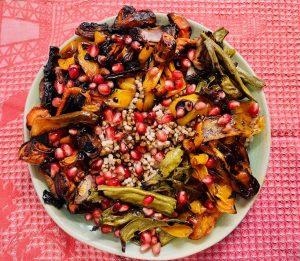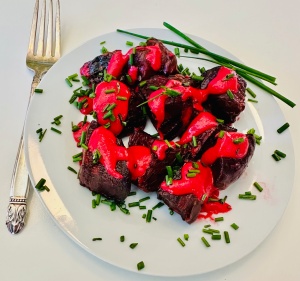Instead of a shank bone, many people now replace it with a roasted beet on their seder plate (z’roa) as a representation of the pascal lamb, for a veg based meal. Inspired by this custom, I decided to prepare a roasted beet dish. I used red beets but you could use golden or an assortment. I love the versatility of beets-raw, roasted, liquified, and more. This one is a combination of roasted beets as well as tahini with roasted beets. Added bonus are the chives I clipped from my sister’s garden to sprinkle on top. Scroll below for the recipe plus my other previous Pesach recipes including karpras salad and olive oil chocolate cake. And, click here to learn about leaving an empty seat at your seder table for a hostage. Continue reading
Tag Archives: recipe
Sukkot Couscous & Fall Vegetables
 I love Sukkot–eating outside, enjoying fall fruits and vegetables, deepening our connections with nature and agricultural cycles. I recently spent time at an incredible native plants nursery near my home. It was fantastic: endless rows of plants native to the Mid-Atlantic region with detailed signs explaining the type of soil and sun they prefer. Between the rows the ground was deep mud and water after heavy rains for two days. Trudging along the rows in my rain boots, I just wanted to buy everything! The native plants are essential because they are “native” to the region in which they evolved and planting them helps to support biodiversity that attracts pollinators such as bees as well as butterflies and birds, better absorbs groundwater retention, and doesn’t require the use of chemicals. Perhaps native plants don’t look as neat and trim as other gardens but they are humming, buzzing and flourishing. The Sukkot dish I made reinforces the importance of local, sustainable agriculture and happens to be easy and delicious. Continue reading
I love Sukkot–eating outside, enjoying fall fruits and vegetables, deepening our connections with nature and agricultural cycles. I recently spent time at an incredible native plants nursery near my home. It was fantastic: endless rows of plants native to the Mid-Atlantic region with detailed signs explaining the type of soil and sun they prefer. Between the rows the ground was deep mud and water after heavy rains for two days. Trudging along the rows in my rain boots, I just wanted to buy everything! The native plants are essential because they are “native” to the region in which they evolved and planting them helps to support biodiversity that attracts pollinators such as bees as well as butterflies and birds, better absorbs groundwater retention, and doesn’t require the use of chemicals. Perhaps native plants don’t look as neat and trim as other gardens but they are humming, buzzing and flourishing. The Sukkot dish I made reinforces the importance of local, sustainable agriculture and happens to be easy and delicious. Continue reading
Sukkot & Simchat Torah: Stuffed eggplants
 Just a quick post to share a stuffed eggplant recipe that is great for both Sukkot and Simchat Torah. Sukkot, an agricultural holiday (ie farm-to-table holiday) that is an opportunity to use the produce that is in abundance at the farmers markets right now makes it one of my favorite holidays. Lots of eggplants are in season at my local farmers markets and the basil was plucked straight from my plants. The filled eggplants are also symbolic of “stuffed” foods commonly eaten on Simchat Torah to represent the Torah scrolls. Scroll to the bottom for more of my Sukkot, Simchat Torah and even Shmini Atzeret recipes. Chag sameach! Continue reading
Just a quick post to share a stuffed eggplant recipe that is great for both Sukkot and Simchat Torah. Sukkot, an agricultural holiday (ie farm-to-table holiday) that is an opportunity to use the produce that is in abundance at the farmers markets right now makes it one of my favorite holidays. Lots of eggplants are in season at my local farmers markets and the basil was plucked straight from my plants. The filled eggplants are also symbolic of “stuffed” foods commonly eaten on Simchat Torah to represent the Torah scrolls. Scroll to the bottom for more of my Sukkot, Simchat Torah and even Shmini Atzeret recipes. Chag sameach! Continue reading
Spring Foraging for Berries
While last spring was remarkable because the world had shut down, spring this year is remarkable as parts of the world start to slowly re-emerge. It was a collective, tragic, exhausting hibernation the past 16 months. When things dramatically stopped last year, my senses became more acute to the subtle, beautiful things in my life, such as wild flowers sprouting from sidewalk cracks, the remarkable shades of green leaves in the forest behind my home, and the symphony of birds that awoke me early every morning.
The covid winter was challenging in many ways but I was very fortunate to always be in good health. On the food front, I became uninspired in my daily cooking and my diet devolved into mainly smoothies, popcorn, and salads. My sole cooking inspiration was to bake breads and cakes for friends and family and the ingredients that were exciting were the ones that I foraged.
Very berry charoset
I created this charoset recipe to use one of my favorite flavor combinations, along with many of the dried berries and fruits I love, such as goji berries, barberries, cherries, elderberries and raisins. But, you could really use any combination of your favorite dried fruits. If you can make this in advance and let it soak overnight, the flavors become more pronounced and the berries plump. Continue reading
Sukkot: Roasted Apples and Yams with Barberries
Like everything else, this is an unusual Sukkot. But due to my COVID routine, I have had the privilege for a deeper physical and sensory connection to the holiday’s harvest themes. It includes more time to tend to edible plants on my balcony and long hikes in woods filled with mushrooms and other edibles. And while the holiday celebrates an agricultural harvest, I like to more broadly think of it as a way to celebrate all of our food sources, whether foraged or grown on a farm. Last weekend, I went on a guided foraging trip just a few miles from my house. In a mere mile long walk, we found more than a dozen edibles, including black walnuts, shiso, sorrel, burr cucumbers, American persimmon, and turkey tail mushrooms. We nibbled little bits of each plant along the way but left everything there for birds and other creatures to enjoy. Continue reading
Roasted Carrots for Rosh Hashana
As we prepare to celebrate Rosh Hashana to mark the birth of the world, it’s hard not to be confused and/or overwhelmed at times by the surreal world we are now living in. From COVID to wildfires to flooding to addressing systemic racism, our physical reality is forever altered.
The past six months have brought to the forefront of our daily lives both the devastating consequences of human actions that are the most un-God-like, but also the incredible, resilient, responses by humans to these crises. When we wish people a healthy, good new year, I cannot think of a time when this has ever meant more than now, for all beings.
Simchat Torah: Zucchini Quiche
 Simchat Torah–which starts Monday night– is the end of a long season of holidays and marked by both completing and beginning the reading of the Torah. But, we are not starting over in the same place with the Torah or in life. Rather, we are like spirals, moving into a new place that is deeply connected to the past. How will we understand or be guided by the Torah in this new cycle and year?
Simchat Torah–which starts Monday night– is the end of a long season of holidays and marked by both completing and beginning the reading of the Torah. But, we are not starting over in the same place with the Torah or in life. Rather, we are like spirals, moving into a new place that is deeply connected to the past. How will we understand or be guided by the Torah in this new cycle and year?
The foods of Simchat Torah usually elongated to represent the Torah scrolls or round to represent hakafot–the circles one dances in to celebrate the holiday. This year, I prepared a vegan zucchini quiche with lots of circles. It’s a great way to use up the season’s last bits of zucchini and is easy to prepare. There are many zucchini varieties and it would be interesting to try an assortment in this dish. Though, I perhaps should have made a dish with the super popular spiralized zucchini! Continue reading
Sukkot: Environmental Refugees and Stuffed Kabocha Squash
 Sukkot is a harvest festival that allows us to experience and reflect upon our vulnerability and fragility in the world. All of the practices of this holiday–celebrating fall harvest foods, inviting community and strangers to one’s sukkah and living in an impermanent dwelling for a week–can be examined through the lens of how we are addressing and will deal with the impacts of climate change crisis. Continue reading
Sukkot is a harvest festival that allows us to experience and reflect upon our vulnerability and fragility in the world. All of the practices of this holiday–celebrating fall harvest foods, inviting community and strangers to one’s sukkah and living in an impermanent dwelling for a week–can be examined through the lens of how we are addressing and will deal with the impacts of climate change crisis. Continue reading
Nina’s Apple Cake
This is the story of an apple cake. But not the ingredients or how to make it. It’s the story of its maker—someone who brought warmth and joy to my family’s home for Shabbat meals and holidays and who selflessly cared for so many people (including painstakingly preparing a beloved cake for voracious eaters!) despite a past that was far from sweet.
The baker of the famous apple cake is Nina Merrick, an 89-year-old resident of Silver Spring, Maryland. She and her husband, Leon, have been friends of my family’s ever since I first began to study with her to prepare for my bat mitzvah, a connection that came about thanks to her lifelong commitment to teaching Judaism. Continue reading






